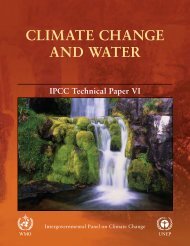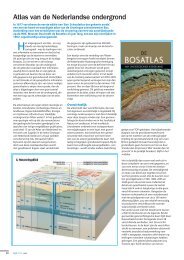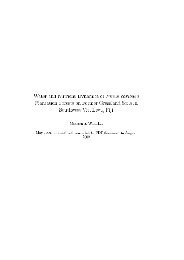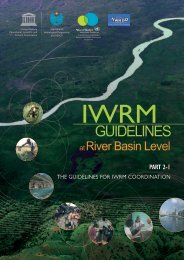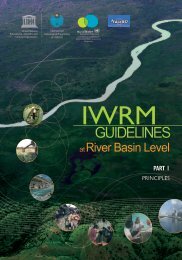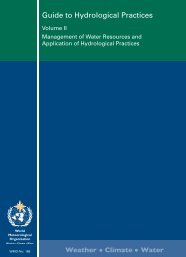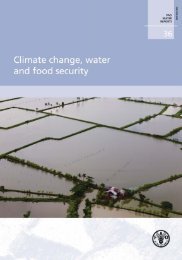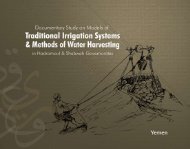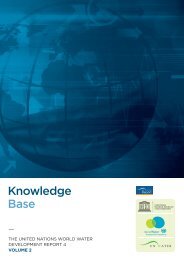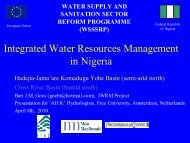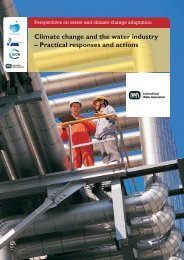Non-renewable groundwater resources: a ... - unesdoc - Unesco
Non-renewable groundwater resources: a ... - unesdoc - Unesco
Non-renewable groundwater resources: a ... - unesdoc - Unesco
- No tags were found...
Create successful ePaper yourself
Turn your PDF publications into a flip-book with our unique Google optimized e-Paper software.
NON-RENEWABLE GROUNDWATER RESOURCES(NSAS), which is overlain by parts of Chad, Egypt, Libya and Sudan; and the North-WesternSahara Aquifer System, better known by its acronym in French as SASS (Système Aquifère duSahara Septentrional), shared by Algeria, Libya and Tunisia. Case studies on these two aquifersystems are attached to this monograph. (case studies).International law has only sparsely taken account of transboundary aquifer systems(UNESCO 2001), be whether they contain <strong>renewable</strong> or non-<strong>renewable</strong> water as it appears in thefollowing.International instruments54While a number of treaties and other legal instruments address <strong>groundwater</strong>, few do so exclusivelyor specifically (Burchi & Mechlem, 2004). In many instances <strong>groundwater</strong> is only nominallyincluded in the scope of a legal instrument. There are, however, both in treaty as well as in nontreatylaw tendencies to develop more <strong>groundwater</strong> specific rules (Mechlem, 2004).At the bi-lateral level, one exception is the 1977 Arrangement relatif à la protection, à l’utilisationet à la réalimentation de la nappe souterraine franco-suisse du Genevois (Agreement on theprotection, utilization and recharge of the Franco-Swiss Genevese aquifer) dealing with <strong>groundwater</strong>quality, quantity, abstraction and recharge. This is a rare example of a treaty dealing exclusivelywith a transboundary aquifer and establishing a joint commission for the management ofthe aquifer. Other treaties deal specifically with <strong>groundwater</strong>, among other subject matters,such as the 1973 agreement between Mexico and the United States on the Permanent andDefinitive Solution to the International Problem of the Salinity of the Colorado River, known asMinute 242. The latter concerns mainly surface water, but contains one provision (paragraph 5)that limits <strong>groundwater</strong> pumping of the Yuma Mesa aquifer by both countries in the immediatevicinity of the Arizona-Sonora boundary near San Luis. It is notable that this provision coversonly one of at least 15 shared aquifers between the United States and Mexico, and was adopted‘pending the conclusion’ between the two governments ‘of a comprehensive agreement on<strong>groundwater</strong> in the border areas’.On the regional level, mention is to be made of two framework agreements tha apply toboth surface and <strong>groundwater</strong>: the 1992 UN ECE Convention on the Protection and Use ofTransboundary Watercourses and International Lakes andthe 2000 Revised Protocol on SharedWatercourses in the Southern African Development Community (Revised SADC Protocol).For the Member States of the European Union the Water Framework Directive (Directive2000/60/EC) provides a very detailed and ambitious regime of <strong>groundwater</strong> quantity andquality control, which is directed at both domestic and transnational situations. A proposal fora directive on the protection of <strong>groundwater</strong> against pollution has been submitted inSeptember 2003 (COM (2003) 550 final). While the Water Framework Directive provides ageneral framework for <strong>groundwater</strong> protection, the purpose of the Groundwater DaughterDirective is to establish specific measures to prevent and control <strong>groundwater</strong> pollution.At the global level, the United Nations Convention on the <strong>Non</strong>-navigational Uses ofInternational Watercourses (Watercourses Convention), prepared by the International LawCommission (ILC) (the United Nations body in charge of codifying and progressively developinginternational law), was adopted on 21 May 1997 by the UN General Assembly after Statenegotiations. The Convention constitutes a major step in the development of internationalwater law. It includes in its scope <strong>groundwater</strong> that is part of a ‘system of surface waters and<strong>groundwater</strong>s constituting by virtue of their physical relationship a unitary whole and normally





